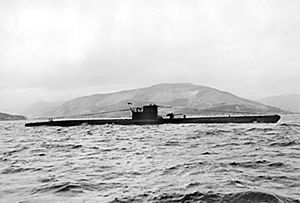German submarine U-907 facts for kids

U-570 Type VIIC submarine that was captured by the British in 1941. This U-boat is almost identical to U-907.
|
|
Quick facts for kids History |
|
|---|---|
| Name | U-907 |
| Ordered | 6 August 1942 |
| Builder | H. C. Stülcken Sohn, Hamburg |
| Yard number | 804 |
| Laid down | 1 April 1943 |
| Launched | 1 March 1944 |
| Commissioned | 18 May 1944 |
| Fate | Surrendered on 9 May 1945; sunk as part of Operation Deadlight on 7 December 1945 |
| General characteristics | |
| Class and type | Type VIIC submarine |
| Displacement |
|
| Length |
|
| Beam |
|
| Height | 9.60 m (31 ft 6 in) |
| Draught | 4.74 m (15 ft 7 in) |
| Installed power |
|
| Propulsion |
|
| Speed |
|
| Range | |
| Test depth |
|
| Complement | 4 officers, 44–52 enlisted |
| Armament |
|
| Service record | |
| Part of: |
|
| Commanders: |
|
| Operations: |
|
| Victories: | None |
The German submarine U-907 was a special type of submarine called a Type VIIC. It was part of Nazi Germany's navy, known as the Kriegsmarine, during World War II.
The order to build U-907 was placed on August 6, 1942. Its construction began on April 1, 1943, at the H. C. Stülcken Sohn shipyard in Hamburg. The submarine was officially launched on March 1, 1944. It was then put into service on May 18, 1944, under the command of a naval officer named Servais Cabolet.
Contents
What Was U-907 Like?
German Type VIIC submarines were a common type of U-boat. U-907 was designed to be powerful and effective underwater.
When it was on the surface, U-907 weighed about 769 tons. When it was fully submerged underwater, it weighed about 871 tons. The submarine was about 67.10 meters (220 feet) long overall. Its main strong outer shell, called the pressure hull, was about 50.50 meters (165 feet) long.
The submarine was about 6.20 meters (20 feet) wide. It stood about 9.60 meters (31 feet) tall from its bottom to the top. The part of the submarine that sat below the water's surface, called the draught, was about 4.74 meters (15 feet).
How U-907 Moved
U-907 used two large diesel engines when it was on the surface. These engines gave it enough power to travel quickly. When it was underwater, it switched to two electric motors. These motors allowed it to move silently beneath the waves.
The submarine had two propellers, each about 1.23 meters (4 feet) wide. These propellers pushed the submarine through the water. U-907 could go as deep as 230 meters (755 feet) underwater.
Speed and Range
On the surface, U-907 could reach a top speed of 17.7 knots (about 32.8 kilometers per hour). When it was submerged, its top speed was 7.6 knots (about 14.1 kilometers per hour).
The submarine could travel a long way without needing to refuel. On the surface, it could go about 8,500 nautical miles (15,742 kilometers) at a speed of 10 knots. Underwater, it could travel about 80 nautical miles (148 kilometers) at 4 knots.
Weapons and Crew
U-907 was equipped with several weapons. It had five torpedo tubes, which are special launchers for torpedoes. Four of these were at the front (bow) and one was at the back (stern). It could carry 14 torpedoes or 26 mines.
For fighting on the surface, it had an 8.8 cm (3.5 inch) deck gun. It also had anti-aircraft guns to defend against planes. These included a 3.7 cm (1.5 inch) Flak M42 gun and two twin 2 cm (0.79 inch) anti-aircraft guns.
The submarine needed a crew of between 44 and 52 sailors to operate it.
What Happened to U-907?
As World War II was ending, U-907 surrendered to the Allied forces. This happened on May 9, 1945, in Bergen, Norway.
After its surrender, the submarine was moved to Loch Ryan, Scotland, on June 2, 1945. U-907 was one of 116 German U-boats chosen to be sunk as part of something called Operation Deadlight. This operation was a plan by the Allied forces to sink captured German submarines so they could not be used again.
On December 7, 1945, U-907 was towed out to sea and deliberately sunk. Its wreck now rests at the bottom of the ocean at coordinates 55°17′N 05°29′W / 55.283°N 5.483°W.

